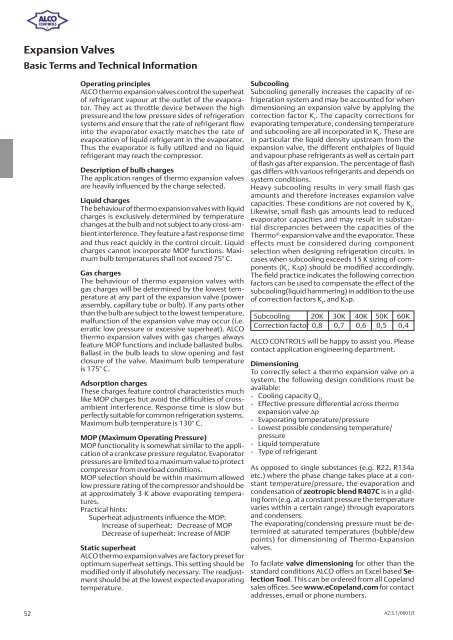Alco Controls - Grobelny
Alco Controls - Grobelny
Alco Controls - Grobelny
You also want an ePaper? Increase the reach of your titles
YUMPU automatically turns print PDFs into web optimized ePapers that Google loves.
Expansion Valves<br />
Basic Terms and Technical Information<br />
52<br />
Operating principles<br />
ALCO thermo expansion valves control the superheat<br />
of refrigerant vapour at the outlet of the evaporator.<br />
They act as throttle device between the high<br />
pressure and the low pressure sides of refrigeration<br />
systems and ensure that the rate of refrigerant flow<br />
into the evaporator exactly matches the rate of<br />
evaporation of liquid refrigerant in the evaporator.<br />
Thus the evaporator is fully utilized and no liquid<br />
refrigerant may reach the compressor.<br />
Description of bulb charges<br />
The application ranges of thermo expansion valves<br />
are heavily influenced by the charge selected.<br />
Liquid charges<br />
The behaviour of thermo expansion valves with liquid<br />
charges is exclusively determined by temperature<br />
changes at the bulb and not subject to any cross-ambient<br />
interference. They feature a fast response time<br />
and thus react quickly in the control circuit. Liquid<br />
charges cannot incorporate MOP functions. Maximum<br />
bulb temperatures shall not exceed 75° C.<br />
Gas charges<br />
The behaviour of thermo expansion valves with<br />
gas charges will be determined by the lowest temperature<br />
at any part of the expansion valve (power<br />
assembly, capillary tube or bulb). If any parts other<br />
than the bulb are subject to the lowest temperature,<br />
malfunction of the expansion valve may occur (i.e.<br />
erratic low pressure or excessive superheat). ALCO<br />
thermo expansion valves with gas charges always<br />
feature MOP functions and include ballasted bulbs.<br />
Ballast in the bulb leads to slow opening and fast<br />
closure of the valve. Maximum bulb temperature<br />
is 175° C.<br />
Adsorption charges<br />
These charges feature control characteristics much<br />
like MOP charges but avoid the difficulties of crossambient<br />
interference. Response time is slow but<br />
perfectly suitable for common refrigeration systems.<br />
Maximum bulb temperature is 130° C.<br />
MOP (Maximum Operating Pressure)<br />
MOP functionality is somewhat similar to the application<br />
of a crankcase pressure regulator. Evaporator<br />
pressures are limited to a maximum value to protect<br />
compressor from overload conditions.<br />
MOP selection should be within maximum allowed<br />
low pressure rating of the compressor and should be<br />
at approximately 3 K above evaporating temperatures.<br />
Practical hints:<br />
Superheat adjustments influence the MOP:<br />
Increase of superheat: Decrease of MOP<br />
Decrease of superheat: Increase of MOP<br />
Static superheat<br />
ALCO thermo expansion valves are factory preset for<br />
optimum superheat settings. This setting should be<br />
modified only if absolutely necessary. The readjustment<br />
should be at the lowest expected evaporating<br />
temperature.<br />
Subcooling<br />
Subcooling generally increases the capacity of refrigeration<br />
system and may be accounted for when<br />
dimensioning an expansion valve by applying the<br />
correction factor K t . The capacity corrections for<br />
evaporating temperature, condensing temperature<br />
and subcooling are all incorporated in K t . These are<br />
in particular the liquid density upstream from the<br />
expansion valve, the different enthalpies of liquid<br />
and vapour phase refrigerants as well as certain part<br />
of flash gas after expansion. The percentage of flash<br />
gas differs with various refrigerants and depends on<br />
system conditions.<br />
Heavy subcooling results in very small flash gas<br />
amounts and therefore increases expansion valve<br />
capacities. These conditions are not covered by K t .<br />
Likewise, small flash gas amounts lead to reduced<br />
evaporator capacities and may result in substantial<br />
discrepancies between the capacities of the<br />
Thermo ® -expansion valve and the evaporator. These<br />
effects must be considered during component<br />
selection when designing refrigeration circuits. In<br />
cases when subcooling exceeds 15 K sizing of components<br />
(K t , K∆p) should be modified accordingly.<br />
The field practice indicates the following correction<br />
factors can be used to compensate the effect of the<br />
subcooling(liquid hammering) in addition to the use<br />
of correction factors K t , and K∆p.<br />
Subcooling 20K 30K 40K 50K 60K<br />
Correction factor 0,8 0,7 0,6 0,5 0,4<br />
ALCO CONTROLS will be happy to assist you. Please<br />
contact application engineering department.<br />
Dimensioning<br />
To correctly select a thermo expansion valve on a<br />
system, the following design conditions must be<br />
available:<br />
- Cooling capacity Q O<br />
- Effective pressure differential across thermo<br />
expansion valve ∆p<br />
- Evaporating temperature/pressure<br />
- Lowest possible condensing temperature/<br />
pressure<br />
- Liquid temperature<br />
- Type of refrigerant<br />
As opposed to single substances (e.g. R22, R134a<br />
etc.) where the phase change takes place at a constant<br />
temperature/pressure, the evaporation and<br />
condensation of zeotropic blend R407C is in a gliding<br />
form (e.g. at a constant pressure the temperature<br />
varies within a certain range) through evaporators<br />
and condensers.<br />
The evaporating/condensing pressure must be determined<br />
at saturated temperatures (bubble/dew<br />
points) for dimensioning of Thermo-Expansion<br />
valves.<br />
To facilate valve dimensioning for other than the<br />
standard conditions ALCO offers an Excel based Selection<br />
Tool. This can be ordered from all Copeland<br />
sales offices. See www.eCopeland.com for contact<br />
addresses, email or phone numbers.<br />
A2.5.1/0601/E


